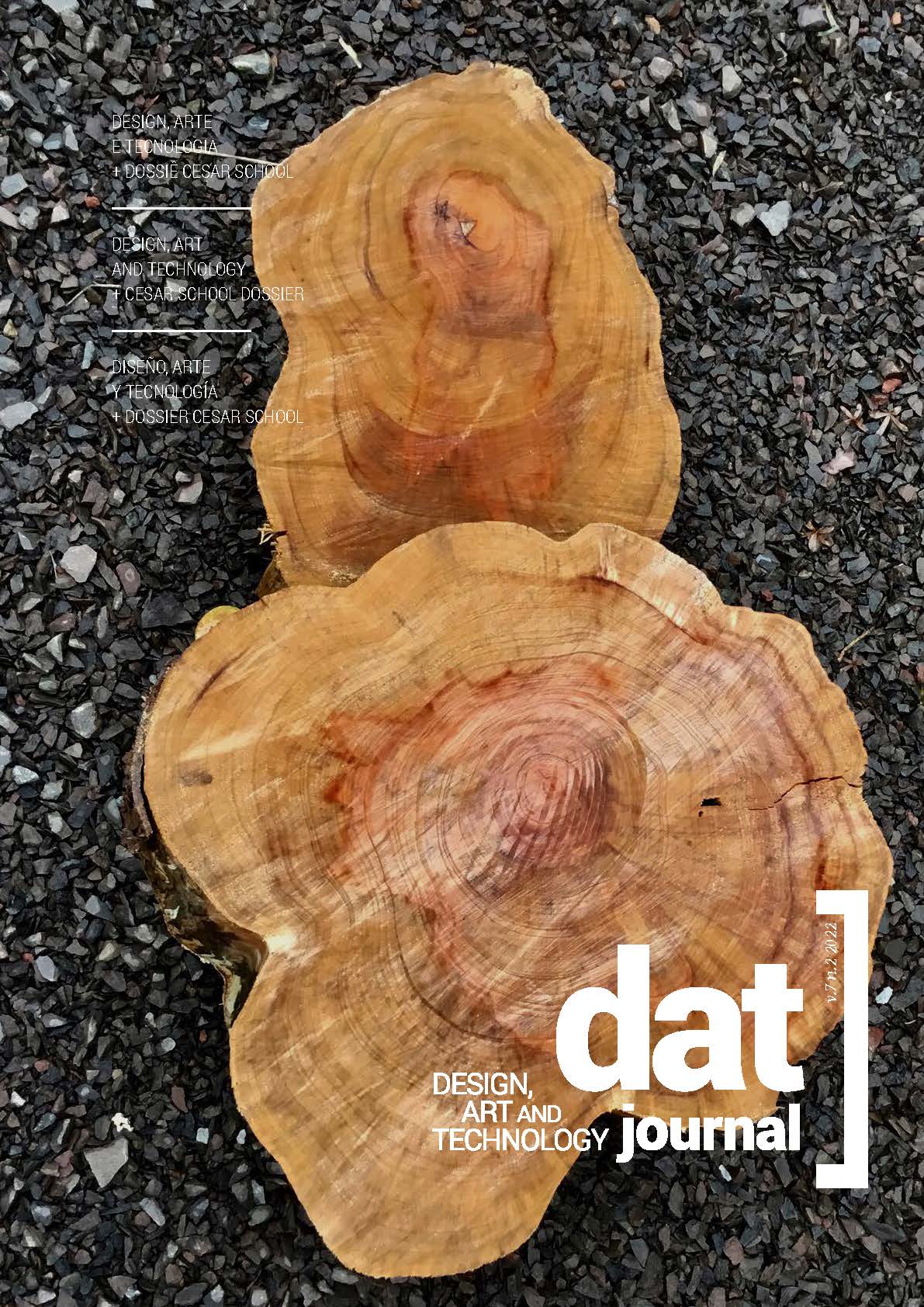Interatividade, Robótica e Arte, desde Altamira
DOI:
https://doi.org/10.29147/datjournal.v7i2.607Palavras-chave:
Arte interativa, Arte robótica, Criatividade computacional, Interatividade, Sociedade ciberfísicaResumo
É possível verificar os efeitos diretos que os ambientes digitais têm na expressão artística e na estética, possibilitando novas experiências perceptivas. Imersão e estímulo são características da experiência artística, porém, com o advento dos ambientes digitais interativos, surge um novo tipo de envolvimento. Na arte interativa baseada em computador, a atividade ocorre por meio do contato entre pessoas e artefatos; o usuário (ou público) e a máquina, juntos, formam uma relação capaz de produzir um resultado artístico único a cada encontro. A noção de “corpo” se expande, abrangendo as dimensões física, mental, emocional, social e virtual. Finalmente, a mistura de humano e não humano, incluindo robôs, sugere novos conceitos e oportunidades. No Japão, a iniciativa Sociedade 5.0 visa aplicar tecnologias emergentes relacionados à robótica social, IA incorporada, IOT, inteligência ambiente, realidade virtual e aumentada e interfaces homem-computador avançadas para melhorar qualitativamente a vida de seres humanos individuais e para beneficiar a sociedade como um todo. Como nos situamos nessas novas realidades e visões de mundo?
Downloads
Referências
Al-Jazari, B. The Book of Knowledge of Ingenious Mechanical Devices, 1206.
Ascott, Roy. Behaviourist Art and the Cybernetic Vision. Cybemetica Vol 9, pp 247-264, 1966.
Candy, L.; Edmonds, E. Interaction in Art and Technology. Crossings: eJournal of Art and Technology - Volume 2, Issue 1, 2002. DOI: https://doi.org/10.1007/978-1-4471-0197-0
Cornock, Stroud, and Ernest Edmonds. The Creative Process Where the Artist Is Amplified or Superseded by the Computer. Leonardo, vol. 6, no. 1, The MIT Press, 1973, pp. 11–16, https://doi.org/10.2307/1572419. DOI: https://doi.org/10.2307/1572419
Dubberly, H.; Pangaro, P.; Haque, U. What Is Interaction? Are there Different Types? Interactions Vol. 16, No. 1, 2009. Gladden, M.E. Who Will Be the Members of Society 5.0? Towards an Anthropology of Technologically Posthumanized Future Societies. Soc. Sci. 8, 148, 2019. DOI: https://doi.org/10.3390/socsci8050148
Gunkel, D. The Machine Question: Critical Perspectives on AI, Robots, and Ethics. Cambridge: The MIT Press, 2012. DOI: https://doi.org/10.7551/mitpress/8975.001.0001
Guinea, G. Altamira y otras cuevas de Cantabria. Madrid: Sílex Ediciones, 1979. ISBN 84-85041-34-8.
Jeon, M., Fiebrink, R., Edmonds, E. A., & Herath, D. (2019). From rituals to magic: Interactive art and HCI of the past, present, and future. International Journal of Human-Computer Studies, 131, p. 108–119, 2019. DOI: https://doi.org/10.1016/j.ijhcs.2019.06.005
Heims, S. J. John von Neumann and Norbert Wiener: From mathematics to the tecnologies of life and death. Cambridge, MA, MIT Press, 1980.
Hornbæk, K.; Mottelson, A.; Knibbe, J.; Vogel, D. What Do We Mean by “Interaction”? An Analysis of 35 Years of CHI. ACM Trans. Comput.-Hum. Interact. 26, 4, Article 27, June 2019. DOI: https://doi.org/10.1145/3325285
Leroi-Gourhan, A. (1983). Los primeros artistas de Europa. Introducción al arte parietal paleolítico. Las huellas del hombre. Madrid: Ediciones Encuentro, 1983. ISBN 84-7490-082-4. p-
Manzolli, J., Variações Robóticas, Publicação Interna, NICS/Unicamp, 2009.
Moro Abadía, O.; González Morales, M. 1864-1902: El reconocimiento del arte paleolítico. Zephyrvs (Publicaciones de la Universidad de Salamanca) (57): p. 119- 135, 2004.
Moroni, A.; Manzolli, J. Robotics, Evolution and Interactivity in Sonic Art Installations. In: New Developments in Evolutionary Computation Research.1 ed. New York, USA: Nova Science Publishers, Inc., p. 159-181, 2015.
Moroni, A.; Manzolli, J. Von Zuben, F. ArTbitration JaVox: Evolution applied to Visual and Sound Composition. In: Ibero-American Symposium in Computer Graphics, 2006, Santiago de Campostela. Eurographics Chapter Proceedings, p.97 – 108, 2006.
Moroni, A.; Manzolli, J. Von Zuben, F. Gudwin, R. Vox Populi: An Interactive Evolutionary System for Algorithmic Music Composition. Leonardo Music Journal. , v.10, p.49 - 54, 2000. DOI: https://doi.org/10.1162/096112100570602
Onday, O. Japan’s Society 5.0: Going Beyond Industry 4.0. Business Economy Journal 10: 389, 2019.
Pike, A.W.G.; Hoffmann, D.L.; García-Díez, M.; Pettitt, P.B.; Alcolea, J.; De Balbín, R.; González-Sainz, C.; Heras, C. de las; Lasheras, J.A.; Montes, R.; Zilhão, J. U-Series Dating of Paleolithic Art in 11 Caves in Spain. Science 336 (6087): 1409-14013, jun 2012. DOI: https://doi.org/10.1126/science.1219957
Richards, W. H. Meet Mr. Robot – Not Forgetting His Master , 1932. https://web.archive.org/web/20170307205535/http://cyberneticzoo.com/robots/1932-%E2%80%93-george-robot-%E2%80%93-capt-w-h-richards-british/ Acessado em 31/01/2022.
Richardson, K. Technological Animism: The Uncanny Personhood of Humanoid Machines. Social Analysis 60: 110–28, 2016. DOI: https://doi.org/10.3167/sa.2016.600108
Schmickl, T.; Bogdan, S.; Correia, L.; Kernbach, S.; Mondada, F.; Bodi, M.; Gribovskiy, A.; Hahshold, S.; Miklic, D.; Szopek, M. ASSISI: Mixing Animals with Robots in a Hybrid Society. In Biomimetic and Biohybrid Systems: Living Machines 2013. Edited by Nathan F. Lepora, Anna Mura, Holger G. Krapp, Paul F. M. J. Verschure and Tony J. Prescott. Berlin/Heidelberg: Springer, pp. 441–43, 2013. DOI: https://doi.org/10.1007/978-3-642-39802-5_60
Shurkin, J. Engines of the mind: the evolution of the computer from mainframes to microprocessors. New York: Norton, 1996.
Turing, A.M. On Computable Numbers, with an Application to the Entscheidungsproblem . Proceedings of the London Mathematical Society, 2. Vol. 42. p. 230–65, 1937. DOI: https://doi.org/10.1112/plms/s2-42.1.230
Vinci, L. Codex Atlânticus. Biblioteca Ambrosiana, Milão, 1519.
Wallach, W.; Allen, C. Moral Machines: Teaching Robots Right from Wrong. Oxford: Oxford University Press, 2008. DOI: https://doi.org/10.1093/acprof:oso/9780195374049.001.0001
Walter, G. An Imitation of Life, Scientific American, May 1950, p. 42-45. DOI: https://doi.org/10.1038/scientificamerican0550-42
Walter, G. A Machine that Learns, Scientific American, August 1951, p. 60-63. DOI: https://doi.org/10.1038/scientificamerican0851-60
Downloads
Publicado
Como Citar
Edição
Seção
Licença

Este trabalho está licenciado sob uma licença Creative Commons Attribution 4.0 International License.


























